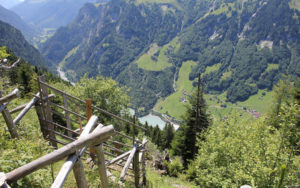
Forests in the mountain regions of our planet are fragile ecosystems, suffering from the impact of climate change. However, to survive in the long-term, these ecosystems do not need human intervention. It is rather the humans in the mountain regions who depend on healthy forests and the protection they provide.
Should we, for example, plant genetically-modified tree species that are particularly resistant to drought, to ensure that mountain forests thrive in the future? This is no joke, but one of the many ideas on how mountain forests should be managed in future, hotly debated at the latest ETH Sustainability Summer School (see box). Thirty-two students from 17 countries and 14 disciplines took an in-depth look at suggestions such as these, which may seem absurd at first glance.
 Wooden tripods protect saplings from snow in the Tamina valley (Image: ETH Sustainability / ETH Zurich)All that mountain forests provide
Wooden tripods protect saplings from snow in the Tamina valley (Image: ETH Sustainability / ETH Zurich)All that mountain forests provide
Mountain forests are more than just a random collection of trees growing on steep slopes. Humans benefit from their many ecosystem services. On a global scale, mountain forests regulate the climate by storing CO2 and water. At the local level, forests protect the surrounding area from natural hazards such as avalanches, landslides and rockfall. In addition, they are important for biodiversity, they provide timber for building and bioenergy, and they supply food such as game, mushrooms and herbs. Forests also enhance the landscape aesthetically, which is invaluable for tourism. Lastly but significantly, mountain forests shape the lowlands: erosion and flooding originate in mountain regions, but they have devastating effect mainly on the low-lying regions.
Most exposed to climate change
The human-induced rise in temperature is twice as high in the mountains as in the lowlands. And, as the reasons for this relate to physics, the trend will likely be the same in future. Hence, mountain regions are particularly affected by climate change; what then are the implications?
The simplest scenario is that a rise in temperature of 4 to 5 degrees Celsius by the year 2100 will shift the vegetation zones by 800 to 1000 metres in elevation. Trees such as beech, cherry or lime, which today thrive at 500 metres above sea level in Zurich, for example, will in future flourish in Davos at 1500 metres. And those species, such as Norway spruce, which today grow well in Davos, will find optimal conditions at 2500 metres, far above the current treeline.
Managing the mountain forests
Mountain forests will doubtless adapt over the long-term to such a drastically different climate. However, going by what we know at present, they will take centuries to do so. In the short-term, many mountain forests will suffer: current tree species will disappear due to extreme circumstances such as drought, insect infestation or windthrow; new species may not migrate quickly enough. Yet, in a hundred or two hundred years’ time, new forests will have replaced the existing ones. So mountain forests can certainly survive without our help!
If, in a place such as Davos, we want to ensure continuing protection of human infrastructure from rockfall or other natural hazards, then we need persistent, healthy mountain forests. So, how should we manage these? This was one of the key themes at the summer school.
Getting to grips with the mountain forest
 (Photo: Stephan Birrer/ Bergwaldprojekt)
(Photo: Stephan Birrer/ Bergwaldprojekt)
In early July, ETH Sustainability together with the Bergwaldprojekt (mountain forest project) and the chair of Forest Ecology ran a nine-day summer school on Mountain Forests & Risk Management at St. Margrethenberg (SG) and in the Tamina valley.
Thirty-two students from 17 countries debated hot questions on the management of mountain forests, and in a three-day practical project session got to grips with the forest itself – building paths and protective frameworks for saplings on a steep slope that had been devastated in 1990 by Hurricane Vivian.
You can find further information on the summer school in Mountain Forests & Risk Management and in the radio article by SRF Regionaljournal Ostschweiz (at 19:30 mins).
It is noticeable that in many mountain forests there are already a few, mostly young specimens of tree species normally found at lower levels. We should systematically promote these individuals to ensure that there are enough seed trees in a couple of decades. We should also consider planting tree species from lower areas at higher elevations. But when is the right time to do so? And should we introduce new species from other continents? Or even work with genetically modified tree species (GMOs)?
Teaching and research play their part
Many questions remain unanswered. So we need highly-qualified forest scientists to work on innovative solutions. And there is demand too for forest science research – on the suitability of ‘exotic’ tree species e.g. from southerly, dry regions, or on genetically modified trees, ones which are particularly resistant to drought, for example. In other countries, GMOs are being intensively researched and also used to a certain extent in commercial forestry; in Switzerland, however, we still don’t permit ourselves to even think about them.
This was not the case at the summer school! Events like this, where bright, young minds from many disciplines come together, may not immediately solve the problem at hand, but they certainly motivate both participants and organisers to step outside of trusted ways of thinking, and question conventional paradigms.
It’s not that I’m unequivocally in favour of GMOs or the introduction of exotic tree species to Switzerland. But one should at least consider them seriously. An out-of-the-ordinary challenge like climate change may demand out-of-the-ordinary solutions!
This blog was originally posted on the 14th of July 2017 on the ETHZ Zukunftsblog and written by Harald Bugmann, professor of forest ecology at the ETH Zurich.

